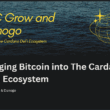Over the years, the blockchain landscape has seen multiple innovative technologies that expand the utility and application of decentralized networks. Integrating satellite data feeds into blockchain oracles provides reliable, transparent, and up-to-date information that can be applied across different industries. The use-cases are unlimited in the modern data-driven ecosystems.
In this article, we explore the collaboration between TxPipe, NMKR, and Gamma Earth that aims to create an open-source oracle system that securely disseminates Earth observation data.
The Need for Satellite Oracles
Earth observation data, collected via satellites, provides invaluable insights into environmental conditions, agricultural productivity, natural disaster management, and much more. However, the current distribution of this data is often centralized, lacks transparency, and is susceptible to tampering. These issues lead to significant distrust and underutilization of critical information, which hampers the potential benefits that such data can offer.
Satellite oracles address these challenges by leveraging blockchain technology to ensure the secure, transparent, and decentralized dissemination of Earth observation data. Oracles act as bridges between the blockchain and the outside world, enabling smart contracts to interact with real-world data. By integrating satellite data into this framework, oracles can provide immutable and verifiable data streams that enhance the reliability and utility of blockchain applications.
Our project builds on an existing system that efficiently collects and processes Earth observation data from satellite sources. This established platform ensures the accuracy and timeliness of the data, leveraging advanced processing algorithms to prepare it for distribution.
To date the product has been used to process over 120 million sq. km of satellite imaging data for large commercial clients including Bayer, CNH, Mahindra, Limagrain, ICL, Varda and others. Since the beginning of May 2024 the system has been released in open access for academic and humanitarian use cases and has gained hundreds of users working on various projects spanning conflict monitoring, flood and natural disaster management as well as a wide array of research activities in ecological studies and natural resource management.
Project Roadmap and Timelines
The scope of this project focuses on the novel dissemination and integration of this data using the Cardano blockchain. By developing an open source oracle, we will enable the transparent distribution of the processed data directly to users and applications.
The oracle, implemented through a combination of off-chain workers and on-chain validators on Cardano, will serve as the first step towards what should become a decentralized oracle system which autonomously handles data transactions ensuring data integrity and security.
Integrating with Cardano allows us to leverage its robust capabilities for handling high transaction volumes and maintaining low operational costs, which is critical for the scalability of our solution. This blockchain integration ensures that all disseminated data is immutable and publicly verifiable, fostering trust and wider acceptance of our platform.
The proposing team has outlined a well-thought plan on implementing the project over a period of 12 months. They’ve divided the project into six major milestones, each with specific deliverables and acceptance criteria as follows:
| Milestone | Objective | Outputs | Acceptance Criteria |
|---|---|---|---|
| Planning and Design (6-8 weeks) | Establish foundational elements including a comprehensive roadmap and initial technical designs | – Complete project plan – System architecture and initial smart contract designs | – Architecture and technical design for use cases (carbon markets, field boundary detection, etc.) – Project plan with at least two major integration use cases |
| Development of the Oracle Infrastructure (12-14 weeks) | Develop and test the Oracle infrastructure necessary for Cardano integration, including on-chain and off-chain components | – Fully functional Oracle infrastructure – Off-chain backend – On-chain validators – API interface – Cloud infrastructure provisioning – Integration test report | – Successful submission and fulfillment of Oracle data requests – Data consistency and performance in tests – Best practices followed |
| Integration with Earth Observation Data Sources (12-14 weeks) | Integrate Oracle infrastructure with external Earth observation data sources | – Operational integration on Cardano testnet – H3 implementation – Schema for data cubes – Advanced features (super-resolution, cloud removal) – API endpoints | – Successful data retrieval and processing from at least two satellite sources |
| Public Testnet Launch (4-6 weeks) | Launch the fully integrated system on the Cardano public testnet, allowing real-world testing and user feedback collection | – Deployment on Cardano testnet for public access and integration testing | – Demonstration of the two selected use cases on the deployed system |
| Integration with NFT Minting Capabilities (4-6 weeks) | Integrate NFT minting capabilities, enhancing data authenticity and traceability on the Cardano blockchain | – Development and integration of NFT minting functions – Framework for issuing NFTs | – Successful minting of NFTs with key data attributes – Functionality and security of NFT transactions on Cardano blockchain |
| Community Engagement and Project Close-out (4-6 weeks) | Engage with the community and evaluate the system’s performance, collecting feedback and validating the project’s impact | – Community engagement initiatives – Project closeout report and video | – At least two workshops/demos with potential users – Completion of project closeout report and video |
Impact and Value Beyond the Cardano Community
Integrating ‘Satellite Oracles’ on Cardano significantly enhances the blockchain’s utility by introducing real-time Earth observation data into its ecosystem. This will drive innovative use cases of blockchain for real-world applications. The investment in this project will:
- Enhance Cardano’s utility: By incorporating Earth observation data, Cardano’s utility in real-world applications increases, attracting new users and developers.
- Drive technological innovation: This project pushes the boundaries of what’s possible with Cardano by integrating cutting-edge technologies in Earth observation and blockchain.
- Generate economic activity: Increased transaction volume from users accessing the data and developers building applications on Cardano will stimulate economic activity within the ecosystem.
- Catalyze community growth: By providing access to vital data, the project supports community-driven initiatives and collaborations, strengthening the overall network.
- Promote environmental sustainability: Enables better decision-making in critical areas such as climate action, agriculture, and urban planning, aligning with global sustainability goals.
Project Budget
To bring the project to life, the proposing parties have requested a total funding of 500,000 ADA in their Fund 12 proposal, which will be spent as follows:
| Project Phase | Details | Cost |
|---|---|---|
| Planning and Design | Project Lead | ₳25k |
| Blockchain Lead | ₳15k | |
| Satellite Tech Lead | ₳25k | |
| NFT Specialist | ₳5k | |
| Additional technical consultants, and administrative expenses | ₳5k | |
| Subtotal | ₳75k | |
| Development of the Oracle Infrastructure | 2 Developers (Rust, Aiken) | ₳80k |
| Tech Lead | ₳40k | |
| Project Lead | ₳10k | |
| Subtotal | ₳130k | |
| Integration with Earth Observation Data Sources | 1 API Developer | ₳60k |
| Tech Lead | ₳60k | |
| Project Lead | ₳10k | |
| Subtotal | ₳130k | |
| Public Testnet Launch | Project Lead | ₳15k |
| Blockchain Lead | ₳35k | |
| Satellite Tech Lead | ₳25k | |
| Hardware and technical expenses | ₳5k | |
| Sub-total | ₳80k | |
| NFT Integration | Budget for developing NFT minting functionalities and integrating them into the existing system. | ₳60k |
| Community Engagement and Project Closeout | Budget for community workshops, and final project reporting. | ₳25k |
| Total funding | ₳500k |
The Proposing Team
The team behind this project consists of seasoned professionals in blockchain, data analytics, and project management. Both TXPipe and NMKR have demonstrated great experience and a proven track record in successfully handling and delivering complex technology projects within the Cardano ecosystem. The collaboration between these stakeholders has entrusted the following team to drive the execution of this project:
- Yosef Akhtman, Earth Observation Technology Lead: Yosef is a technologist and founder with deep expertise in Remote Sensing, Environmental Monitoring, Geo-Information Systems, and Machine Learning. He founded Gamma Earth in 2020, focusing on developing advanced Earth Observation technologies for environmental monitoring and precision farming. He also founded and led Gamaya, a Swiss startup in precision agriculture.
- Shay Gammer, Project Lead/Manager: Shay is a seasoned professional with a rich background in computer science and finance, adept at leveraging blockchain technologies to drive innovation. Responsible for overseeing the project, coordinating efforts, managing resources, and ensuring the project’s overall success.
- Santiago Carmuega, founder TxPipe and Blockchain Developer: He will be responsible for developing the smart contract architecture on Cardano, ensuring the secure and efficient operation of decentralized oracles.
- Patric Tobler, NMKR CEO – NFT Specialist: Focused on integrating NFT technologies to represent or certify Earth observation data on the Cardano blockchain, enhancing data authenticity and traceability.
- Nils Helset, Digifarm CEO – 15th generation farmer in Norway. Extensive experience with precision agriculture services and agronomy – over 8 years experience in crop-producing. Digifarm will provide an AI layer on top of the image processing focused on agriculture farm borders. This will be part of the content added to the Oracle.
Putting it all together
The integration of satellite data feeds not only showcases Cardano’s robust capabilities in handling large-scale, decentralized data applications but also attracts new users and developers interested in environmental data and related technologies. The availability of reliable and transparent environmental data through Cardano will encourage the development of new applications across various sectors, including agriculture, finance (micro finance, insurance), climate action (forest conservation, carbon) , and urban planning. This will lead to increased use cases for Cardano, thereby strengthening its value proposition.
Additionally, by fostering a community around satellite data, we aim to catalyze partnerships with environmental organizations and educational institutions, enhancing Cardano’s reputation as a platform for innovative and impactful solutions.










